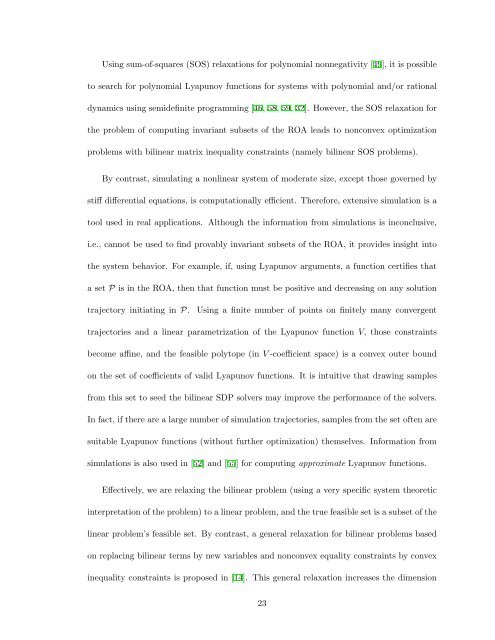Quantitative Local Analysis of Nonlinear Systems - University of ...
Quantitative Local Analysis of Nonlinear Systems - University of ...
Quantitative Local Analysis of Nonlinear Systems - University of ...
You also want an ePaper? Increase the reach of your titles
YUMPU automatically turns print PDFs into web optimized ePapers that Google loves.
Using sum-<strong>of</strong>-squares (SOS) relaxations for polynomial nonnegativity [49], it is possible<br />
to search for polynomial Lyapunov functions for systems with polynomial and/or rational<br />
dynamics using semidefinite programming [46, 58, 59, 32]. However, the SOS relaxation for<br />
the problem <strong>of</strong> computing invariant subsets <strong>of</strong> the ROA leads to nonconvex optimization<br />
problems with bilinear matrix inequality constraints (namely bilinear SOS problems).<br />
By contrast, simulating a nonlinear system <strong>of</strong> moderate size, except those governed by<br />
stiff differential equations, is computationally efficient. Therefore, extensive simulation is a<br />
tool used in real applications. Although the information from simulations is inconclusive,<br />
i.e., cannot be used to find provably invariant subsets <strong>of</strong> the ROA, it provides insight into<br />
the system behavior. For example, if, using Lyapunov arguments, a function certifies that<br />
a set P is in the ROA, then that function must be positive and decreasing on any solution<br />
trajectory initiating in P.<br />
Using a finite number <strong>of</strong> points on finitely many convergent<br />
trajectories and a linear parametrization <strong>of</strong> the Lyapunov function V, those constraints<br />
become affine, and the feasible polytope (in V -coefficient space) is a convex outer bound<br />
on the set <strong>of</strong> coefficients <strong>of</strong> valid Lyapunov functions. It is intuitive that drawing samples<br />
from this set to seed the bilinear SDP solvers may improve the performance <strong>of</strong> the solvers.<br />
In fact, if there are a large number <strong>of</strong> simulation trajectories, samples from the set <strong>of</strong>ten are<br />
suitable Lyapunov functions (without further optimization) themselves. Information from<br />
simulations is also used in [52] and [55] for computing approximate Lyapunov functions.<br />
Effectively, we are relaxing the bilinear problem (using a very specific system theoretic<br />
interpretation <strong>of</strong> the problem) to a linear problem, and the true feasible set is a subset <strong>of</strong> the<br />
linear problem’s feasible set. By contrast, a general relaxation for bilinear problems based<br />
on replacing bilinear terms by new variables and nonconvex equality constraints by convex<br />
inequality constraints is proposed in [14]. This general relaxation increases the dimension<br />
23













